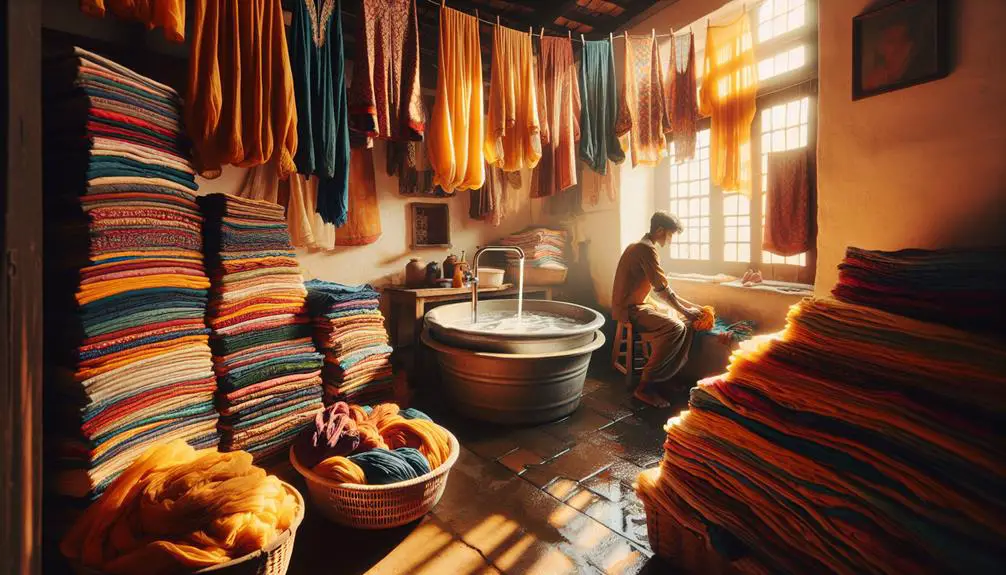Have you ever wondered if following care labels truly extends the life of your fabrics? Experts suggest that understanding the unique properties of different materials plays an important role in fabric longevity. By adhering to specific washing, drying, and ironing instructions, you can maintain the integrity of your garments. But what about those stubborn stains or the best ways to store your clothes? There are several key strategies you might not have considered that can have a meaningful impact on how long your fabrics last. Let's explore these expert tips to make sure your favorite pieces stay in top condition for years to come.
Table of Contents
Key Takeaways
- Always follow care labels for washing, drying, and ironing instructions.
- Sort laundry by color and fabric type to prevent damage.
- Use eco-friendly detergents and cold water to preserve fabric quality.
- Store fabrics in cool, dry, and dark places to avoid deterioration.
- Repair and reinforce seams promptly to extend garment lifespan.
Understand Fabric Types
To make your fabrics last longer, you first need to understand the different types of materials you're dealing with. Fabric care starts with a solid foundation of material knowledge. Different fabrics have unique properties and require specific handling to maintain their integrity and appearance over time.
Start by identifying whether your fabric is natural, synthetic, or a blend. Natural fibers like cotton, linen, wool, and silk each have distinct characteristics. Cotton, for instance, is soft and breathable but can shrink if not handled properly. Linen is durable and absorbent but wrinkles easily. Wool is excellent for insulation yet prone to felting if exposed to heat and agitation. Silk, known for its luxurious feel, is delicate and requires gentle care.
On the other hand, synthetic fibers such as polyester, nylon, and acrylic are designed for durability but can suffer from issues like pilling or static.
Blended fabrics combine the best of both worlds but come with their own set of care instructions.
Proper Washing Techniques
When washing your fabrics, understanding and following the correct techniques can greatly extend their lifespan. To achieve this, you need to take into account the specific requirements of different materials.
Firstly, always check the care labels. They provide essential information on whether to opt for handwashing vs machine washing. Delicate fabrics like silk and wool often require handwashing to prevent damage, while sturdier materials can handle the machine.
Using eco-friendly detergents is another critical step. These detergents are gentle on fabrics and also better for the environment. They contain fewer harsh chemicals, which helps preserve the integrity of your fabrics over time.
Here are some expert tips to improve your washing techniques:
- Sort your laundry: Separate clothes by color and fabric type to prevent bleeding and wear.
- Use cold water: Hot water can cause shrinkage and fading, while cold water is gentler and more energy-efficient.
- Avoid overloading your machine: Overcrowding can lead to inadequate cleaning and increases fabric friction, causing wear and tear.
- Pre-treat stains: Address stains promptly with a gentle, eco-friendly stain remover to avoid permanent marks.
Mastering these techniques will ensure your fabrics stay vibrant and durable for a longer period.
Optimal Drying Methods
Ensuring your fabrics dry properly is essential for maintaining their quality and longevity. Air drying is one of the best methods you can use, as it avoids the wear and tear caused by heat. Simply hang your clothes on a line or drying rack in a well-ventilated area. This method allows fabric fibers to relax without the stress of high temperatures.
For those times when you need to use a machine, select the tumble dry option on low heat. This setting minimizes the risk of shrinking and damage. It's especially important for delicate fabrics and garments with heat-sensitive fibers. You can also use heat setting techniques to lock in fabric treatments or finishes, but always check the care label first.
Here's a quick reference table to help you choose the best drying method for different fabrics:
| Fabric Type | Recommended Drying Method |
|---|---|
| Cotton | Air drying or tumble dry, low heat |
| Wool | Air drying |
| Synthetic blends | Tumble dry, low heat |
| Delicate fabrics | Air drying |
Ironing and Steaming Tips
Mastering the art of ironing and steaming can greatly extend the life of your fabrics while keeping them looking pristine. Both techniques are essential for crease prevention and wrinkle release. Here's how you can perfect your approach:
Start with the right temperature setting. Always check the care label on your garments to select the appropriate heat level. High temperatures can damage delicate fabrics, while too low a setting won't be effective.
Garment steaming is a fantastic alternative to traditional ironing. It's especially useful for delicate materials and items with intricate details. Steaming not only smooths out wrinkles but also refreshes the fabric without direct contact.
For efficient wrinkle release, invest in a high-quality iron with steam capabilities. The steam helps relax fibers, making it easier to smooth out stubborn creases. Don't skip the water reservoir; it's your best ally in achieving a flawless finish.
Here are some effective ironing hacks to elevate your technique:
- Use a pressing cloth to protect delicate fabrics from direct heat.
- Iron clothes inside out to prevent shine marks and preserve colors.
- Hang garments immediately after ironing to maintain the wrinkle-free look.
- Utilize garment steaming for quick touch-ups and to avoid over-ironing.
Stain Removal Strategies
When tackling stains, you should start with effective pre-treatment techniques to loosen the grime.
Next, choose the right cleaning agents specific to the type of stain and fabric.
Pre-Treatment Techniques
Effective stain removal starts with knowing the right pre-treatment techniques for different types of stains. Mastering these methods not only aids in immediate stain management but also plays an essential role in fabric preservation and longevity maintenance.
Different stains require different approaches; here's how you can tackle some of the common ones:
- Oil-based stains: For oil stains, act quickly by sprinkling baking soda or cornstarch to absorb the oil. Let it sit for 10-15 minutes before brushing it off and applying a liquid dish soap.
- Protein stains (like blood or sweat): Use cold water to rinse the stain as soon as possible. Avoid hot water, as it can set the stain. Apply a mixture of cold water and enzyme-based detergent.
- Tannin stains (like coffee or wine): Blot the stain with a clean cloth to remove excess liquid. Then, apply white vinegar or lemon juice, followed by a gentle rub with a soft brush.
- Ink stains: Dab the stain with rubbing alcohol using a cotton ball. Be sure to blot, not rub, to prevent the ink from spreading.
Effective Cleaning Agents
A variety of cleaning agents can make tackling stubborn stains much easier and more effective. For fabric preservation, consider eco-friendly alternatives that not only protect your clothes but also the environment.
White vinegar and baking soda are excellent DIY solutions that can handle most stains. Simply mix them into a paste and apply directly to the stain before washing. This method is gentle on fabrics and enhances longevity.
For more persistent stains, oxygen-based cleaners are highly effective. They lift stains without the harsh chemicals found in traditional bleach, maintaining the integrity of your fabrics. Always follow the manufacturer's guidelines for best results.
When selecting commercial products, opt for those labeled biodegradable or plant-based. These eco-friendly alternatives reduce chemical exposure and are less likely to degrade fabric fibers over time.
Lastly, remember that the sooner you treat a stain, the better. Immediate action prevents stains from setting, making them easier to remove and extending the life of your garments.
Mastering these stain removal strategies not only keeps your clothes looking fresh but also supports fabric preservation, ensuring your wardrobe remains in top condition for years to come.
Avoiding Common Mistakes
Now that you know about effective cleaning agents, let's explore common mistakes to avoid in stain removal to guarantee your fabrics last longer. Even the smallest misstep can compromise your fabric care efforts, so it's important to get this right from the start.
First, never rub a stain vigorously; this can damage the fibers and set the stain deeper. Instead, blot gently with a clean cloth. Using hot water can also be a big mistake, as it tends to set protein-based stains like blood and sweat. Opt for cold or lukewarm water as a safer alternative.
Here are some key tips to follow:
- Test First: Always test your cleaning solution on a small, inconspicuous area of the fabric to verify it doesn't cause discoloration or damage.
- Act Quickly: The longer a stain sits, the harder it's to remove. Immediate action can make all the difference.
- Use Proper Tools: Employ soft brushes or sponges instead of harsh scrubbers to preserve the fabric's integrity.
- Mind Your Storage Solutions: Proper storage can prevent stains from setting in the first place, so keep fabrics in clean, dry, and dark places.
Mastering these strategies will significantly improve your fabric care routine.
Storage Best Practices
When storing your fabrics, choose a cool, dry place to prevent moisture damage and fading. Start by investing in vacuum sealing to protect your fabrics from dust, insects, and fluctuating temperatures. This method guarantees temperature control, which is essential for maintaining fabric integrity. Vacuum sealing also minimizes exposure to air, reducing the risk of oxidation and mold growth.
Next, think about moth prevention. Moths can wreak havoc on your fabrics, especially natural fibers like wool and silk. Instead of relying on chemical repellents, consider natural remedies. Cedar blocks, lavender sachets, and cloves are excellent for deterring moths while adding a pleasant scent to your storage area. These natural options are effective without introducing harmful chemicals to your fabrics.
Proper storage isn't just about where you store your fabrics, but how you organize them. Fold heavier fabrics neatly and place them at the bottom of the stack to avoid creasing lighter materials. Use acid-free tissue paper between layers to prevent color transfer and creases. Label your stored fabrics clearly, so you can easily find what you need without rummaging through the entire collection.
Following these best practices will guarantee your fabrics remain in pristine condition for years to come.
Repair and Mending
When your favorite fabric starts showing signs of wear, patchwork techniques can give it a new lease on life. Reinforcing seams can also prevent small tears from turning into bigger problems.
These simple methods can greatly extend the lifespan of your textiles.
Patchwork Techniques
Mastering patchwork techniques can breathe new life into your favorite worn-out garments. Not only do these methods offer a sustainable solution, but they also allow you to showcase your creativity.
Start by selecting fabrics that complement your garment. Color coordination ideas can elevate your patchwork from simple repair to a fashion statement. Think about using contrasting or harmonizing colors to add visual interest and unity to your piece.
For creative designs, consider incorporating various shapes like squares, triangles, or even abstract forms. This approach turns your patch into a unique feature rather than a hidden fix. Upcycling projects become an exciting challenge when you repurpose old fabrics, turning them into DIY crafts that are both functional and beautiful.
Here are some expert tips to get you started:
- Choose high-quality fabric scraps: They'll last longer and look better.
- Use interfacing: This adds strength and durability to your patches.
- Experiment with stitching styles: Try zigzag, blanket stitch, or even decorative embroidery.
- Pre-wash fabrics: Prevents future shrinking and guarantees color fastness.
Seam Reinforcement
While patchwork techniques add flair to your repairs, strengthening seams guarantees your garments remain sturdy and wearable. Seam reinforcement is essential for fabric care and enhancing durability factors.
Start by choosing the right thread selection for your fabric. Polyester threads offer strength and elasticity, making them ideal for most garments. For delicate fabrics like silk, opt for fine cotton threads to prevent unnecessary stress.
Mastering stitching methods is indispensable. Backstitching provides a strong, durable seam; it's perfect for high-stress areas like underarms and crotches. For added security, consider the zigzag stitch, which allows for flexibility while maintaining seam integrity. Reinforcing seams with a French seam or a flat-felled seam not only adds strength but also gives a professional finish.
Durability factors come into play with your stitching methods and thread selection. Always start and end your seams with a few backstitches to lock the thread in place. Regularly inspect high-stress areas and reinforce them before they become a problem.
Seasonal Care Advice
Proper seasonal maintenance guarantees your favorite fabrics stay in excellent condition year-round. To achieve this, it's important to adjust your care routine according to the season.
First, consider your seasonal storage methods. Storing fabrics improperly can lead to damage, so always use breathable containers and avoid plastic bags that trap moisture. For added fabric protection, incorporate cedar blocks or lavender sachets to ward off pests like moths.
When shifting between seasons, remember to clean your fabrics before storage. Dirt and oils attract insects and can cause long-term damage. Pay special attention to delicate items and make sure they're stored flat to avoid stretching.
Here are some expert tips to enhance your seasonal care routine:
- Use breathable garment bags: They allow airflow and prevent mildew.
- Avoid direct sunlight: UV rays can fade and weaken fabrics.
- Rotate your wardrobe: This ensures even wear and reduces strain on specific items.
- Invest in quality hangers: Padded or wooden hangers can help maintain the shape of your garments.
Professional Cleaning Secrets
Revealing professional cleaning secrets can greatly prolong the lifespan of your fabrics.
First, let's talk about dry cleaning. This specialized cleaning process uses non-water-based solvents to remove stains without damaging delicate fibers. Always choose a reputable dry cleaner who understands the nuances of different fabrics. Improper handling can lead to shrinkage or color fading, compromising the integrity of your cherished garments.
Another key aspect is fabric restoration. Over time, even the most well-cared-for fabrics can suffer from wear and tear. Professional fabric restorers use advanced techniques to mend tears, reweave holes, and restore color. This expertise ensures your items return to their former glory, extending their usable life significantly.
Additionally, always inspect your garments before and after professional cleaning. Look for any loose threads, missing buttons, or minor damages that need attention. Communicate these issues to your dry cleaner, as they can often address them during the cleaning process.
Frequently Asked Questions
How Can I Prevent Fabric From Fading Over Time?
To prevent fabric fading, wash clothes in cold water and avoid direct sunlight. Use fabric fading prevention detergents and turn garments inside out. These longevity maintenance strategies will help keep your fabrics vibrant and long-lasting.
What Are the Best Eco-Friendly Products for Fabric Care?
You should explore natural alternatives like vinegar and baking soda for green cleaning. Sustainable solutions include eco options like wool dryer balls and biodegradable detergents. These choices guarantee you're caring for fabrics while protecting the environment.
How Do Fabric Softeners Impact Fabric Longevity?
Fabric softeners can make fabrics feel softer but might reduce their longevity by weakening fibers. Consider alternatives to fabric softeners, like vinegar or wool dryer balls, which offer pros and cons without compromising fabric integrity.
Can Certain Detergents Damage Specific Fabric Types?
You might think all detergents are safe, but detergent selection is essential for fabric care. Certain detergents contain harsh chemicals that can damage delicate fabrics like silk or wool, so choose wisely to guarantee longevity.
How Often Should I Rotate Seasonal Clothing in Storage?
You should rotate your seasonal wardrobe in storage every six months. This clothing rotation helps maintain organization and guarantees that your garments remain in good condition, reducing stress on the fabrics from prolonged storage.
- How Does Ring Spun Cotton Affect Garment Fit and Shape Retention? - August 13, 2024
- What Are the Challenges in Producing Ring Spun Cotton? - August 13, 2024
- Is Ring Spun Cotton Suitable for Plus-Size Clothing? - August 13, 2024




